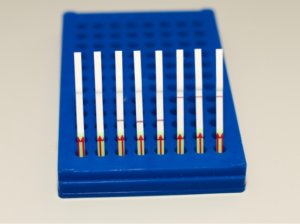Normally, CRISPR is synonymous with gene editing to correct mistakes in the genome. However, this new CRISPR-based tool is using CRISPR in a whole new appllication – to detect the presence of a specific DNA or RNA. In doing so, it may help millions of people determine if they have been infected with an infectious disease such as Zika or Dengue viruses.
The tool is called SHERLOCK (Specific High Sensitivity Enzymatic Reporter UnLOCKing) and has been called a DNA/RNA equivalent to the pregnancy test.
One of the huge benefits of SHERLOCK is that viruses can be detected directly from liquid biological samples such as blood or saliva. No DNA or RNA extraction, no pipettes, no highly trained personnel. Just a person’s saliva and a piece of paper.

SHERLOCK will allow for the quick and cheap detection of viral infection, allowing scientists to implement treatment of infected individuals quickly. It will also allow for much more real-time tracking of outbreaks aiding in rapid outbreak response. And, in a massive outbreak, sometimes life or death comes down to a matter of hours.
The ability of the tool, which was developed by researchers at the Broad Institute, to detect Zika virus and dengue virus present in very small amounts (1 virus particle per microliter), was highlighted in a paper published in Science.
The paper introduces a new technique named HUDSON (Heating Unextracted Diagnostic Samples to Obliterate Nucleases) that can lyse viral particles while keeping their RNA preserved. Used in conjunction with SHERLOCK, this method could identify the viruses in patient samples in a matter of a few hours. Not only that, but, using this technology, the researchers could also identify between strains of dengue virus.
In testing, the system had 100 percent specificity and sensitivity and no false positives when tested using healthy urine.
One of the authors, Omar Abudayyeh, said that “The really great thing about the SHERLOCK assay is how easy it is to redesign and deploy.” “We’ve shown that we can detect dozens of different targets, and we can design these assays in as little as a week. That speaks to how robust it is, and how well it works for each given set of CRISPR RNAs. It’s as easy as designing a new CRISPR RNA and then showing that it works.”
Like all things CRISPR, the speed and efficiency with which this technology has been developed is astonishing. Although implementing it in the field may take more time, there is no reason to think that this will not be a game changer in outbreak response.
For a video explanation of SHERLOCK, please watch these videos made by the Broad Institute or by Science magazine, both of which explain the potential of this new tool.
Julianna LeMieux received her Ph.D. in Molecular Biology and Microbiology from Tufts University School of Medicine where she studied the pathogenic bacteria Streptococcus pneumoniae. She is especially interested in infectious diseases, global health and vaccines. Follow her on Twitter @julemieux1
A version of this article was originally published on the American Council on Science and Health’s website as “A CRISPR-Based Home Test For Zika” and has been republished here with permission.































